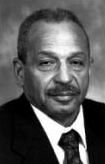Maxie Clarence Maultsby Jr. facts for kids
Quick facts for kids
Maxie Clarence Maultsby Jr.
|
|
|---|---|
 |
|
| Born | April 24, 1932 |
| Died | August 28, 2016 (aged 84) |
| Nationality | American |
| Alma mater | Talladega College, B.A., Case Western Reserve University Medical School, M.D. |
| Known for | Founding of the Rational Behavior Therapy method, Rational Self-Counseling technique, and the New Self-Help ... Prevention Treatment Method |
| Awards | Elected Distinguished Life Fellow of the American Psychiatric Association, recipient of the Lifetime Achievement Award from the National Association of Cognitive-Behavioral Therapists |
| Scientific career | |
| Fields | Psychiatry, emotional and behavioral self-management |
| Institutions | Philadelphia General Hospital, US Air Force, University of Wisconsin, Madison, University of Kentucky, Howard University, Saint Elizabeth's Hospital |
| Influences | Alexander Luria, B.F. Skinner, Albert Ellis |
Maxie Clarence Maultsby Jr. (born April 24, 1932, in Pensacola, Florida – died August 28, 2016, in Alexandria, Virginia) was an American doctor who specialized in helping people with their thoughts and feelings. He wrote several books about how to manage your emotions and actions. He was highly respected in his field, earning awards like the Lifetime Achievement Award from the National Association of Cognitive-Behavioral Therapists. Dr. Maultsby created a special way of helping people called Rational Behavior Therapy. He also developed a self-help method called Rational Self-Counseling, which teaches people how to guide themselves to better emotional health. He was a professor at Howard University in Washington D.C..
Contents
Early Life and Education
Maxie Maultsby was born in Pensacola, Florida, in 1932. He finished high school in Orlando, Florida, in 1949. He then went to Talladega College in Alabama, where he earned his first degree in 1953. After that, he studied medicine at Case Western Reserve University in Cleveland, Ohio, and became a medical doctor in 1957.
After medical school, he worked as an intern at a hospital in Philadelphia for a year. Then, he moved to Cocoa, Florida, to work as a general doctor. In 1962, he joined the US Air Force as a medical officer for four years. Later, he trained to become a psychiatrist, which is a doctor who helps people with their mental health. He also learned special techniques like Behavior Therapy and Autogenic Training, which are ways to help people change their thoughts and actions.
Helping People with Psychiatry
In 1970, Dr. Maultsby started working at the University of Wisconsin, Madison. A year later, he became a professor there and also directed a program for adults needing psychiatric help at the University of Kentucky.
In 1973, Dr. Maultsby started his own center called the Training and Treatment Center for Rational Behavior Therapy. This center helped make his new approach, Rational Behavior Therapy, more widely known. He led this center until 1987. During this time, he worked with another famous therapist, Albert Ellis. Together, they showed that many people can learn to control their emotions by thinking things through logically. They found that by changing their mental habits, people could overcome negative thoughts and live happier lives.
In the mid-1980s, Dr. Maultsby worked with Dr. O. Carl Simonton, a doctor who helped cancer patients. They used Dr. Maultsby's self-help tools to support cancer patients and their families. Later, Dr. Maultsby became the head of the Psychiatry Department at Howard University in 1989. He was given the title of Emeritus Professor there in 2004, which means he was a retired professor who kept his title because of his important work.
What Made Rational Behavior Therapy Special?
Dr. Maultsby's Rational Behavior Therapy (RBT) brought new ideas to how we understand and treat mental health. Here are some of its unique contributions:
- It is based on how a healthy human brain works. This is different from some other therapies that rely more on just thinking about feelings or philosophical ideas.
- RBT is fairly easy to learn and teach. You don't need to know a lot of medical terms to understand it.
- It helps people figure out what "healthy thinking" means for them personally.
- People learn to become their own therapists, using a method called Rational Behavior Self-Counseling.
- In 1971, RBT doctors were among the first to use visualization and mental imagery. This means using your imagination to create healthy thoughts, feelings, and behaviors.
- RBT explained that when you try to change old habits, it might feel strange or "wrong" at first. This feeling is normal and is part of the process of making positive changes.
- It respects that religious, spiritual, or deep personal beliefs can be helpful for mental health. RBT shows how these beliefs can fit into a healthy way of thinking and counseling.
The International Association for Clear Thinking
In 1978, Dr. Maultsby started a non-profit organization called The International Association for Clear Thinking, Inc. (IACT). This group helps people reduce stress and difficult emotions by teaching them how to think clearly and counsel themselves.
After Dr. Maultsby left in 1990, the organization continued its work. IACT offers self-help materials and workshops for free, supported by donations. The IACT program uses research from experts in cognitive behavior therapy, including Dr. Maultsby and Albert Ellis. Their methods, like "Rational Self Counseling" and "Clear Thinking Criteria," show that with practice, people can get rid of unhelpful thoughts and behaviors that cause unhappiness and stress.
Global Impact
Dr. Maultsby taught at many universities and led workshops around the world. He was very interested in finding simple, affordable ways to make classrooms places where students could also learn about emotional health. Rational Behavior Therapy has continued to grow and is now used by therapists in many countries. Dr. Maultsby had a strong following not only in the United States but also in places like South Africa, Finland, and Poland. Many students learned from him, including Aldo R. Pucci, T. Allen Gore, and psychiatrists Aleksandra Wirga and Mariusz Wirga.

